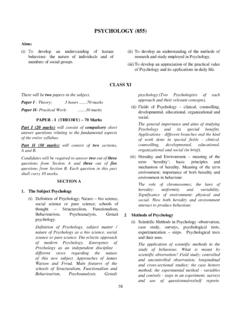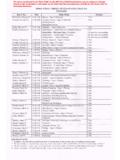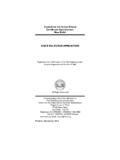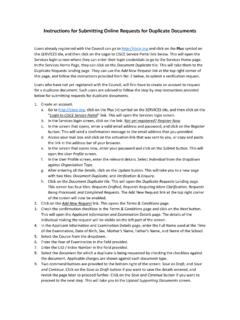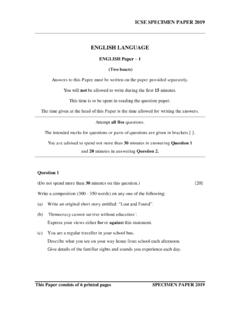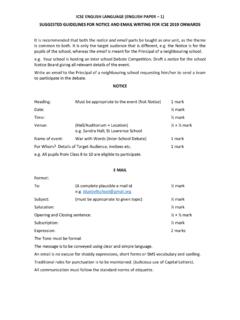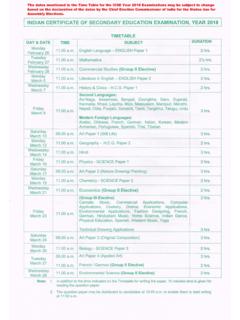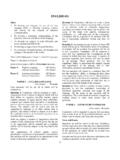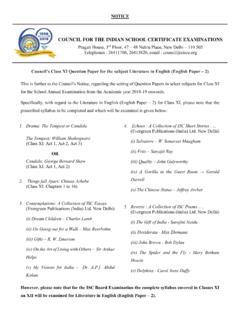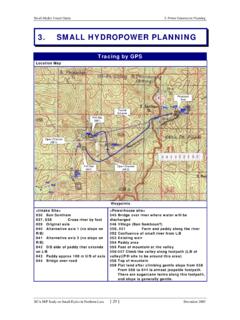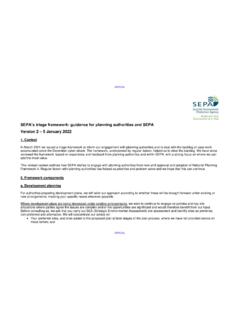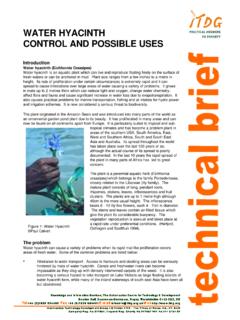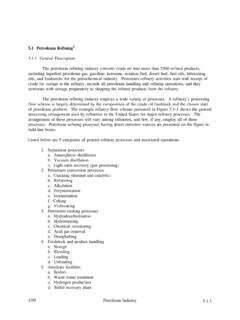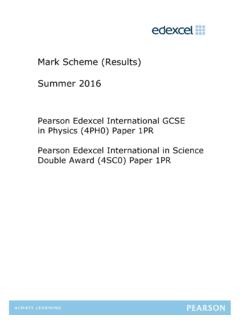Transcription of SCIENCE (5 2) - CISCE
1 97 SCIENCE (52)PHYSICSSCIENCEP aper-1 acquire knowledge and understanding of theterms, facts, concepts, definitions, laws, principlesand processes develop skills in practical aspects of handlingapparatus, recording observations and in drawingdiagrams, graphs, develop instrumental, communication,deductive and problem-solving discover that thereis a living and growingphysics relevant to the modern age in which IXThere will be one paperoftwohoursdurationcarrying 80 marks and Internal Assessment ofpractical work carrying 20 paper will be divided intotwosections,Section I (40 marks) and Section II (40 marks).
2 Section I(compulsory) will contain short answerquestionson the entire IIwill contain six questions. Candidates willbe required to answer anyfourof :Unless otherwise specified, only SIUnits are tobe used while teaching and learning, as well as foranswering Measurements and Experimentation(i)International System of Units,the requiredSI unitswith correct symbols are given atthe end of this commonlyusedsystem ofunits-fps and cgs.(ii)Measurements using commoninstruments,Verniercallipersandmic ro-metrescrewgauge for length, and simplependulum of length using, Verniercallipersandmicro-metrescrew to an increase inaccuracy;least-count (LC)of Verniercallipers and screw gauge),zero error(basicidea),(nonumerical problems on callipersand screw gauge),simple pendulum; timeperiod, frequency, graph of length l versusT2only; slope of the graph.
3 Formula T=2..gl[noderivation]. Only simple in One DimensionScalar and vectorquantities, distance, speed,velocity, acceleration; graphs of distance-time andspeed-time; equations of uniformly acceleratedmotion with of Scalar and vector quantities only,rest and motionin one dimension;distance anddisplacement; speed and velocity; accelerationand retardation; distance-time and velocity-timegraphs; meaning of slope of the graphs; [Non-uniform acceleration excluded].Equations to be derived: v = u + at;S = ut + at2;S = (u+v)t; v2= u2+ 2aS.[Equation for Snthisnotincluded].Simple numerical Laws of Motion(i) Contact and non-contact forces; cgs & SI of contact forces (frictional force,normal reaction force, tension force asapplied through strings and force exertedduring collision) and non-contact forces(gravitational, electric and magnetic).
4 General properties of non-contact forces. cgsand SI units of force and theirrelationwithGravitationalunits.(ii) Newton s First Law of Motion (qualitativediscussion) introduction ofthe idea of inertia,massand 's first law; statement and qualitativediscussion; definitions of inertia and forcefrom first law, examples of inertia asillustration of first law. (Inertial massnotincluded).98(iii)Newton s Second Law of Motion (includingF=ma); weight and study of the second law. Linearmomentum, p= mv; change in momentum p= (mv) = m v for mass remaining constant,rate of change of momentum; p/ t = m v / t = ma or}ma=t)u-v(m=tmu-mv=tp-p{12;Simplenumer ical problems combiningF= p / t = ma and equations of of force-only cgs and SI.
5 (iv)Newton s Third Law of Motion (qualitativediscussion only); simple with qualitative discussion;examples of action-reaction pairs,(FBAandFAB);action and reaction always act ondifferent bodies.(v)GravitationUniversal Law of Gravitation.(Statementandequation)and its ,acceleration due to gravity, free fall. Weightand mass, Weight as force of gravitycomparison of mass and weight; gravitationalunits of force,(Simplenumerical problems),(problems on variation of gravity excluded) (i)Change of pressure with depth(including theformula p=h g); Transmission of pressure inliquids; atmospheric andPressureand theirunits; pressureexerted by a liquidcolumn p= h g; simpledaily life examples, (i) broadness of the baseof a dam, (ii) Diver s suit etc.
6 Someconsequences of p= h g;transmission ofpressure in liquids; Pascal's law; examples;atmosphericpressure;common of pressurewith altitude,(qualitative only); applicationssuch as weather forecasting and altimeter.(Simplenumerical problems)(ii)Buoyancy,Archimedes Principle;floatation;relationship with density; relative density;determination of relative density of a , upthrust (FB); definition; differentcases, FB>, =or <weight W of the bodyimmersed; characteristic properties ofupthrust; Archimedes principle; explanationof cases where bodies with density >, = or< the density ' of the fluid in which it Density (RD)and Archimedes determination of RDof a solid and liquid denserthan : principle of floatation.
7 Relationbetweenthe density of a floating body,densityof the liquid in which it is floating and thefraction of volume of the bodyimmersed;( 1/ 2= V2/V1); apparent weight of floatingobject; application to ship, submarine,iceberg, balloons, problems involvingArchimedes principle, buoyancy Energy(i)Concepts of heat as energy,SI unit joule,1 cal = J exactly.(ii)Anomalous expansion of water; graphsshowing variation of volume and density ofwater with temperature inthe 0to s experiment andconsequencesof Anomalousexpansion.(iii)Energy flow and its importance:Understanding the flow of energy as Linearand linking it with the laws ofThermodynamics- Energy is neither creatednor destroyed and No Energy transfer is100% efficient.
8 (iv)Energy ,wind, water and nuclear energy (onlyqualitative discussion of steps to produceelectricity). Renewable versus non-renewablesources (elementary ideas with example).Renewable energy: biogas, solar energy,wind energy, energy from falling of water,run-of-the river schemes, energy from waste,tidal energy, etc. Issues of economic viabilityand ability to meet energy coal, oil, naturalgas. Inequitable use of energy in urban andrural areas. Useof hydroelectrical powersfor light and tube wells.(v)Global warming and Green House effect:Meaning, causes and impact on the life for the future; what needsto be degradation meaning and Light(i)Reflection of light;images formed by a pair ofparallel and perpendicular plane mirrors;Laws of reflection; experimental verification;characteristics of imagesformed in a pair ofmirrors,(a) parallel and (b) perpendicular toeach other; uses of plane mirrors.
9 (ii)Spherical mirrors; characteristics of imageformed by these concave andconvex mirrors.(Only simple direct raydiagrams arerequired).Brief introductiontospherical mirrors-concaveand convex mirrors,centreandradius of curvature, pole and principal axis,focus and focal length;location of imagesfrom ray diagram for various positions of asmall linear object on the principal axis ofconcave and convex mirrors; characteristicsof = R/2(withoutproof);sign convention anddirect numerical problems using the mirrorformulae are included. (Derivationofformulae not required)Uses of spherical drawing or graphical representation ofray diagrams not Sound(i)Nature ofSound ofamedium for sound waves to travel;propagationand speedin different media;comparison with speed of propagation,terms frequency (f),wavelength ( ), velocity (V), relationV=f.
10 (Simplenumerical problems)effectof differentfactorson thespeed of sound; comparison ofspeed of sound with speed of light;consequences of the large difference in thesespeeds in air; thunder and lightning.(ii)Infrasonic,sonic, ideas and simple between ultrasonic Electricity and Magnetism(i)Simple electric circuit using an electric celland a bulb to introduce the idea ofcurrent(including its relationship to charge); potentialdifference; insulators and conductors; closedand open circuits; direction of current(electron flow andconventional)Current Electricity: brief introduction ofsources of direct current-cells, accumulators(construction, working and equationsexcluded).
